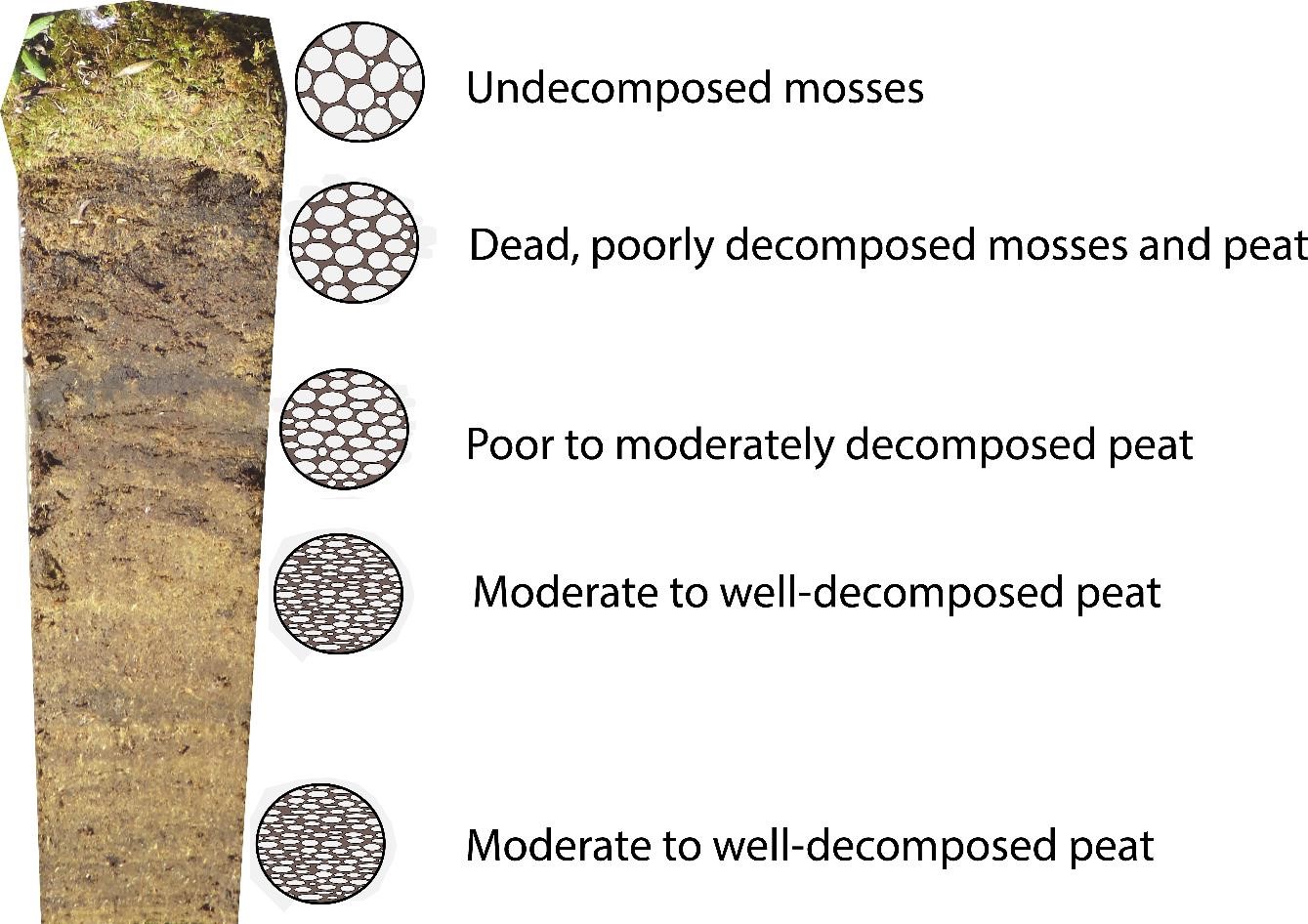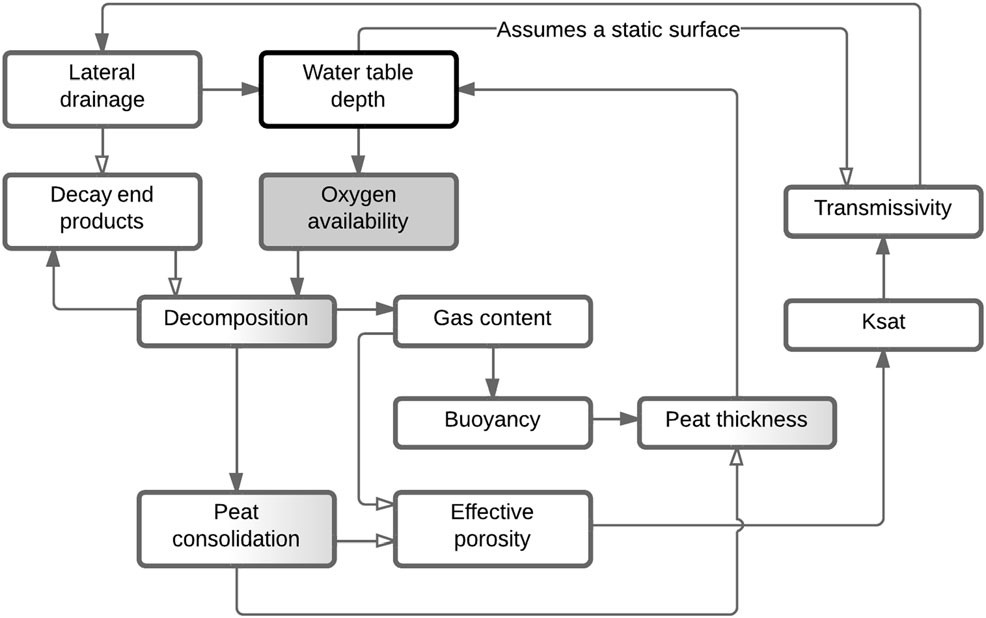3 Peat: A Porous Medium
In peatlands, peat is the aquifer material that governs the flow of water and thus its connectivity with local and regional groundwater aquifers. Water flow through peat is affected by the properties of the matrix, thus by its botanical source and the combined impact of decomposition and compaction, which vary with depth. Peat is a porous medium whose hydraulic character can be described with terms similar to those used for mineral sediments. However, the physical and chemical properties of peat that affect flow and transport are distinctly different from those in mineral soils (Table 1). Peat is a porous matrix with exceptionally high total porosity (up to 98 percent), only a portion of which conducts water flow.

Peat consists of organic materials that begin to decompose at the time of their deposition. Hence, the organic materials deposited initially at the inception of the peatland eventually form the basal peat layer. Peat physical properties vary with time since deposition due to ongoing decomposition and compression typically results in more decomposed and consolidated peat with depth (Figure 8); however, less decomposed layers may occur if, for example, they were deposited during cooler and wetter periods that reduced decomposition.

Figure 8 – Vertical profile of the upper ~60 cm of bog peat, dominated by Sphagnum mosses. In the accompanying graphic, organic matter is represented with black and gray, while pore space is white. The living moss occupies the topmost layer characterized by large open pores, resting on the remains of the dead, poorly decomposed mosses immediately below. At depth, the structure of the matrix is noticeably different, wherein the peat is more decomposed and partially compressed by the weight of the overlying material, reducing the pore-size and causing pore shapes to flatten. In this profile, indicated by “moderately decomposed peat,” a distinct banding can be seen, possibly reflecting periods of higher and lower decomposition associated with warmer/drier and cooler/wetter periods of climate. In the lower section of the peat profile, moderate to well decomposed peat is indicated. In this particular profile, plant fragments are still visible at depth, so decomposition is moderate rather than well decomposed. Photograph of core is from Ahad and others, 2020, with modified perspective.
For peat to form, the average annual rate of plant matter accumulation must exceed the average annual rate of its decay. Vegetative matter is added at and near the ground surface, and decomposition occurs throughout the peat profile. In tropical forests, peat formation in tip-up pools formed by uprooted trees — which are often more than a meter deep — is an important zone of carbon accumulation (Domain et al., 2015). The upper layer is variably saturated and comprises relatively easily decomposed carbon compounds; decomposition by aerobic microbial processes in this zone is relatively rapid. Deeper peat is perpetually saturated (notwithstanding some biogenic gases that may be present), relatively resistant to decay, and thus decomposition by anaerobic bacteria occurs very slowly. At higher latitudes and/or altitudes, low ground temperatures also reduce the rate of peat decomposition.
The upper layer of the peat profile is sometimes called the acrotelm, whose depth is approximated by the mean annual maximum water table depth. Defining this operationally is difficult, but conceptually it is the zone of variable saturation. Below the acrotelm, where the peat is perpetually saturated, is the catotelm (Ingram, 1978). This relatively simplistic model of peatlands is useful for identifying distinctly different layers with contrasting hydrological, geochemical, and ecological processes (Rezanezhad et al., 2016). However, others have challenged it as overly simplistic, and recognize the importance of spatially distinct hotspots as being critical to peatland function (Morris et al., 2011), especially since many peatlands are characterized by various forms of microtopographic relief (e.g., hummock/hollows, ridges/depressions) that have distinctly different hydraulic and biogeochemical characteristics (Baird et al., 2016).
For the purpose of discussing groundwater processes, living mosses as well as dead but poorly decomposed and well decomposed plant material (peat) are all part of the matrix through which water and solute flow occurs. Since the physical structure of peat degrades as plant matter decomposes and pore spaces collapse, its hydraulic properties change accordingly. This includes a decrease of hydraulic conductivity, porosity, and drainable porosity with depth (Rezanezhad et al., 2016). For some peatlands— notably bogs and to a lesser extent, fens — the hydraulic conductivity can decrease by 4 to 5 orders of magnitude between the top and bottom of the acrotelm (approximately the upper 30 to 50 cm of peat), whereas within the catotelm, the hydraulic conductivity is generally lower than the minimum in the acrotelm and has less depth-dependent variability (McCarter and Price, 2017a). However, there are exceptions to this trend (Chason and Siegel, 1986). While the concept of acrotelm technically applies to swamps, the relatively amorphous degraded peat in many swamps does not commonly have distinct vertical patterns of variability of hydraulic conductivity, porosity, or drainable porosity.
Similarly, in disturbed peatlands where the acrotelm layer has been removed or highly degraded, the concept of a distinct acrotelm does not apply, or at least, is not useful. In most bogs and fens, however, the change in hydraulic character with depth both depends on, and controls, the hydrology of the system. This creates a critical ecohydrological feedback that regulates peatland form and function (Figure 9). Waddington and others (2015) provide a good discussion of hydrological feedbacks.

Figure 9 – The water table depth-peat decomposition feedback. Solid and outline arrows represent positive and negative relationships, respectively. Gray shading indicates a process in the unsaturated zone, white is the saturated zone and the white-to-gray transition implies both the saturated and unsaturated zone. Water table depth is a function of external water exchanges, for a given peat thickness. Peat thickness is controlled by organic matter input, subject to decomposition and consolidation, which affects peat structure including its porosity, hydraulic conductivity, and transmissivity. (From Waddington et al., 2015)
